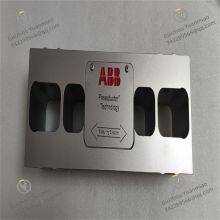Material
Other, Global universal model
Condition
Other, Global universal model
Task
Other, Global universal model
Mathematical Model
Other, Global universal model
Signal
Other, Global universal model
Customized
Non-Customized
Structure
Other, Global universal model
Operating Temperature
-40°C to +70°C
ABB PFTL101B 20.0KN 3BSE004203R1Overview
The ABB PFTL101B 20.0KN 3BSE004203R1 is a pillow-type weighing sensor specifically designed for precise measurement of applied weight or force in various complex application scenarios. With ABB's deep technical accumulation and excellent craftsmanship in the sensor manufacturing field, this product plays a key role in weighing systems for industrial and commercial sectors, providing solid support for industries with strict requirements for weighing accuracy and reliability. Its design aims to achieve high-precision measurement while balancing durability and installation convenience, enabling seamless integration into different types of equipment and system architectures.
Functional FeaturesHigh-Precision Measurement Performance
Adopting advanced measurement technologies and precision manufacturing processes, it provides extremely accurate weight or force measurement results. Whether under normal working conditions or facing measurement requirements for minor force changes, it can capture and feedback data with extremely high precision, ensuring the accuracy and stability of measurement results to effectively meet application scenarios with rigorous measurement accuracy requirements.
Durable and Reliable Construction
Made of high-quality materials and featuring a robust structural design, it has excellent resistance to impact, vibration, and environmental interference. Even in harsh industrial environments such as high humidity, strong electromagnetic interference, or drastic temperature changes, it can operate stably, ensuring long-term reliable performance output and significantly reducing equipment maintenance frequency and replacement costs.
Convenient Pillow-Type Design
The unique pillow-type shape makes installation simpler and easier to integrate into existing systems. This design not only reduces installation space occupation but also optimizes adaptability with surrounding equipment. It can easily handle horizontal, vertical, or inclined installation methods, greatly improving installation efficiency and the flexibility of system layout.
Wide Load-Bearing Capacity
With a load-bearing capacity of up to 20.0KN, it is suitable for various weighing applications from light to heavy loads. Whether for precise weighing of small components or weight monitoring of large equipment and materials, it can cope with with its strong load-bearing capacity, demonstrating good versatility and applicability.
Flexible Configuration Options and Accessories
It offers rich configuration options, allowing users to flexibly adjust sensor parameters through professional software or hardware settings according to actual needs. Meanwhile, it has multiple optional accessories to further expand its functions, meeting personalized customization requirements of different users and providing comprehensive solutions for diversified application scenarios.

Working Principle
The PFTL101B 20.0KN 3BSE004203R1 achieves weight or force measurement based on specific physical principles. Its internal core components use changes in physical properties of materials under force to sense external forces. When an external force is applied to the sensor, the internal sensitive elements deform or change physical parameters accordingly. For example, based on the magnetostrictive effect, the magnetic permeability of the internal magnetic materials in the sensor changes under mechanical stress.
The sensor consists of a set of specially treated laminations as the measurement body, with primary and secondary windings wound through four holes in the sensor and crossing each other. When an alternating current is applied to the primary winding, a magnetic field is generated around it. When the sensor is not under force, the secondary winding does not generate a magnetic field because the primary and secondary windings are perpendicular to each other. When the sensor is subjected to mechanical force in the measurement direction, the propagation of the magnetic field changes, causing a magnetic field around the secondary winding and inducing an alternating voltage in it. The control unit converts this alternating voltage into a direct voltage output proportional to the applied force. If the direction of the measured force changes, the polarity of the sensor signal will change accordingly. By precisely measuring and analyzing the output voltage signal, the magnitude and direction of the applied force or weight can be accurately obtained.
Application FieldsPaper Industry
It plays a key role in the paper production process, applicable to weight and tension monitoring of equipment such as paper machines, calenders, coaters, and winders. By accurately measuring the force on paper in different production links, it ensures stable tension during paper production, guarantees uniform paper quality, avoids problems such as wrinkles and breakage, and improves the efficiency and quality of paper production.
Industrial Manufacturing Field
Suitable for weighing links in the production and processing of various industrial products. For example, in the manufacturing process of components, raw materials, semi-finished products, and finished products are precisely weighed to ensure product quality meets standards; in automated assembly lines, it is used to monitor the weight and transportation of materials, achieve precise material distribution and production process control, and improve production efficiency and product consistency.
Logistics and Warehousing Industry
Used for weighing and metering of goods. Whether in the links of goods warehousing, ex-warehousing, or inventory counting, it can accurately record the weight of goods with its high-precision measurement capability, provide reliable data support for logistics management, optimize logistics distribution processes, reasonably arrange warehouse space, and reduce logistics costs.
Transportation Field
Widely applied in vehicle weighing, cargo loading monitoring, etc. For example, in road transportation, it is used to detect the load of trucks, prevent overloading, and ensure road traffic safety; in railway, aviation, and other transportation modes, it precisely measures the weight of goods to ensure the load balance of transport vehicles and flight safety.










































